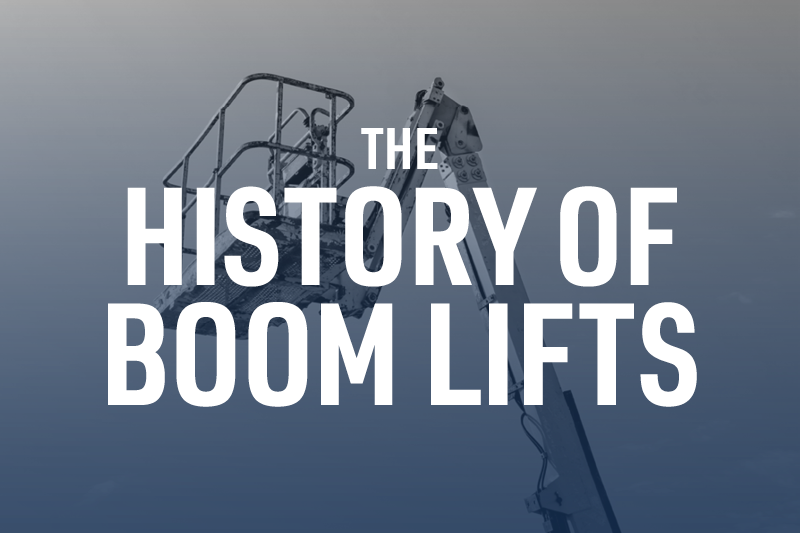
Many people are surprised to learn boom lifts originated in a Canadian apple grove, not a cherry orchard. A machine conceived to pick fruit sprouted a diverse range of equipment used in agriculture, construction and the world’s biggest sports arenas.
Read on to test your knowledge of boom lifts including:
- The difference between a boom lift vs. a cherry picker vs. a telehandler
- How far can the biggest boom lift reach?
- What does “JLG” stand for?
Cherry Pickers vs. Boom Lifts and Telehandlers
A boom lift is a type of mobile elevated work platform (MEWP). Boom lifts are a type of man lift commonly used by firefighters, utility companies and construction crews.
Some people call boom lifts cherry pickers, but that isn’t always accurate. Cherry pickers have to be towed from place to place, whereas boom lifts are self-propelled. Also, cherry pickers can’t be moved with the boom arm extended, but a boom lift operator can drive the lift even while in the air.
If you see a set of forks at the end of the boom, it’s probably a telehandler. Telehandler forklifts, sometimes called boom forklifts, are a cross between a rough terrain forklift, a boom lift and a crane.
Now that we have all that nitpicky stuff sorted out, let's move on to the history and fun facts! A quick shout-out to Cranes & Access magazine for their extensive historical research and reporting.
The First Boom Lift
The first self-propelled boom lift was invented by Canadian W.E. "Ted" Thornton-Trump in Oliver, British Columbia, Canada. After seeing a pneumatic pruning machine, Thornton-Trump was inspired to create a similar device to improve the efficiency and safety of apple picking.
As you can imagine, sticking a ladder into soft, uneven ground isn’t very secure. Add a heavy basket full of apples, and you have a recipe for falls, strains and other injuries.
Thornton-Trump’s first invention, the Giraffe, was a double boom hydraulic lift that allowed workers to pick apples from the highest branches and return to the ground safely, even when laden with heavy fruit. The first Giraffe sold in November 1951 for $2000 (Canadian dollars).
The Giraffe had to be towed from one place to another by an orchard tractor and required two operators — one for the tractor and one for the lift. So, technically the world’s first cherry picker was invented in an apple orchard. There’s some food for thought.
In 1956, Thornton-Trump debuted a new invention: the Girette. Self-powered and self-propelled, the single-boom Girette was a major step forward. By 1962, Girettes were sold in 43 countries. There were 12 different models, including three designed for firefighting.
In 1961, Carl Ruegg of Selma, CA purchased the designs for the Tree Farmer, a self-propelled boom lift designed by farmer John Baerg. In 1962, Ruegg’s company developed the Tree Master. It had a larger platform and a 27-foot working height. When non-agricultural companies became interested in the lifts made in Selma, the product and company name were rebranded to “Manlift” (acquired by JLG in 2004).
Working heights topped out at 47 feet until JLG stepped in with a game-changer...
JLG’s Big Innovation
In 1970, Condor Industries (which later became JLG) brought the first telescoping boom lift to market. The first “Condorlift” had a 27 foot working height.
FUN FACT: One of Condor’s founders was a man named John L. Grove. Now you know where the company name “JLG” comes from.
In 1972, JLG released a 65 foot boom lift quickly followed by a modified version with larger outriggers that provided a working height of 80 feet. JLG introduced the first scissor lift in 1976, but that’s another story....
Genie's Articulating Boom Lifts
In 1985, Genie started selling an articulating boom lift, the Z-30/20, which is still available today. Articulating boom lifts are sometimes called “knuckle booms” or “up-an-over boom lifts.”
Telescoping vs. Articulating Boom Lifts
A telescoping boom lift can go up and across, but an articulating boom lift can go up and under or up and around. Watch this short video clip to see what articulating boom lift can do.
Boom Lifts Reach New Heights in the ‘90s and 2000s
- 1991 JLG releases the first 150-foot boom lift (the 150HAX)
- 1994 JLG starts selling electric boom lifts
- 2013 Genie debuts a 180-foot telescopic boom lift with a rotating articulated jib (the SX-180)
- 2014 JLG tops Genie with the 1850SJ, a boom lift with a platform height of 185 feet, 7 inches and an 80 foot horizontal reach.
- 2020 Snorkel announces the 2100SJ Mega Boom. With a platform height of 216 feet and horizontal reach of 100 feet, the Mega Boom lives up to its name and (as of writing) is the world’s largest telescoping boom lift.
Compact Crawlers, Hybrid and Self-Leveling Boom Lifts,
Compact Crawlers
In 2010, JLG started its line of compact crawlers, a towable boom lift that can fit through standard doorways. They’re ideal for painting, HVAC maintenance, tree trimming and electrical work.
FUN FACT: JLG equipment has been made in the USA since its founding in 1969.
Hybrid Boom Lifts
In 2014, JLG released its first hybrid boom lift, the H340AJ articulating boom lift. Hybrid boom lifts can be powered by electricity or internal combustion — similar to a hybrid car.
With a hybrid lift, you get the emission-free benefits of an electric vehicle and the go-anywhere power of IC equipment. Both Genie and JLG offer hybrid boom lifts. Genie’s hybrid boom lifts can work a full day on a single charge or run for an entire week on a single tank of diesel.
Self-Leveling Boom Lift
In 2020, JLG introduced a self-leveling boom lift because JLG engineers “realized that the industry...had designed current lifts for the near ideal conditions of firm, flat surfaces with a grade of 5 degrees or less [but] the world is neither flat, nor does it come with improved surfaces.”
Their innovation, the 670SJ self-leveling boom:
- Can operate on slopes up to 10°
- Minimizes the time and labor costs required to crib and/or grade the work area
- Reduces the need for earthmoving equipment
- Decreases platform movement during travel, improving operator comfort and safety
Buy or Rent a Boom Lift in the Mid-South
Our experienced and friendly experts can help you choose the right mobile elevated work platform for your operational needs and budget. The Lilly Company is an authorized forklift dealer for Genie, AICHI, JLG throughout Alabama, Mississippi, Tennessee and eastern Arkansas.
Contact an aerial lift expert at The Lilly Company online or by phone 844-LILLYCO (1-844-545-5926) with any questions you have, or come say “hello” at one of our 13 locations across the Mid-South.
Arkansas - Jonesboro
Alabama - Birmingham, Dothan, Irondale, Madison, Mobile, and Montgomery
Mississippi - Tupelo and Richland
Tennessee - Jackson, Kingsport, Knoxville, and Memphis
Further Reading:
The History of Forklifts
The History of Pallets and Pallet Racking
Posts by Tag
- Forklift (61)
- Forklift Service (19)
- Electric Forklifts (16)
- Forklift Safety (14)
- Forklift Attachments (12)
- Toyota Forklifts (12)
- Warehouse Planning (10)
- Parts (9)
- Warehouse Automation (8)
- Clark Forklifts (7)
- Loading Docks (7)
- Material Handling Education (7)
- Pallet Racking (7)
- Customer Solutions (6)
- Forklift Batteries (6)
- Purchasing Options (6)
- Aerial Equipment (5)
- Forklift Rental (5)
- Heavy Equipment (5)
- Forklift Accessories (4)
- Forklift Fleet Management (4)
- Forklift Tires (4)
- Forklift Training (4)
- Products (4)
- Utility Vehicles (4)
- Yard Spotter Trucks (4)
- Linde (3)
- Specialty Forklifts (3)
- Used Equipment (3)
- IC Forklifts (2)
- Manitou (2)
- Pallet Jacks (2)
- Warehouse Doors (2)
- COMBiLift (1)
- Custom Shop (1)
- Forklift Brakes (1)
- Forklift Warranty (1)
- Gehl (1)
- Komatsu (1)
- Product Review (1)
- Recruitment (1)











